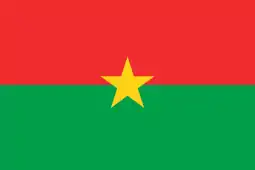Demographics of Burkina Faso
This article is about the demographic features of the population of Burkina Faso, including population density, ethnicity, education level, health of the populace, economic status, religious affiliations and other aspects of the population.
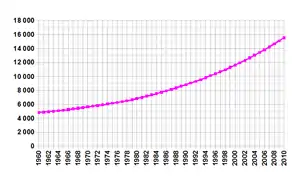
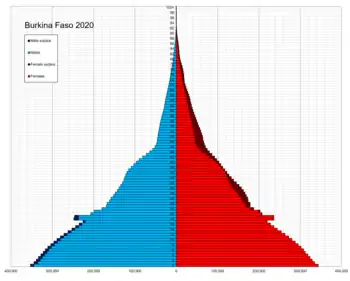
Burkina Faso's 19.8 million people belong to two major West African cultural groups—the Gur (Voltaic) and the Mandé. The Voltaic are far more numerous and include the Mossi, who make up about one-half of the population. The Mossi claim descent from warriors who migrated to present-day Burkina Faso and established an empire that lasted more than 800 years. Predominantly farmers, the Mossi are still bound by the traditions of the Mogho Naba, who hold court in Ouagadougou.
About 12,000 Europeans reside in Burkina Faso, the majority of whom are French.
Most of Burkina Faso's population is concentrated in the south and center of the country, with a population density sometimes exceeding 48 inhabitants per square kilometer (120 inhabitants per square mile). This population density, high for Africa, causes annual migrations of hundreds of thousands of Burkinabé to Ivory Coast and Ghana for seasonal agricultural work. About a third of Burkinabé adhere to traditional African religions. The introduction of Islam to Burkina Faso was initially resisted by the Mossi rulers. Christians, predominantly Roman Catholics, are largely concentrated among the urban elite.
Few Burkinabé have had formal education. Schooling is free but not compulsory, and only about 29% of Burkina's primary school-age children receive a basic education. The University of Ouagadougou, founded in 1974, was the country's first institution of higher education. The Polytechnic University of Bobo-Dioulasso in Bobo-Dioulasso was opened in 1995.

Population
According to the United Nations' Population Division, the total population was 20,903,000 in 2020, compared to only 4,284,000 in 1950.[1] The proportion of children below the age of 15 in 2020 was 44.4%, 53.2% of the population was between 15 and 65 years of age, while 2.4% was 65 years or older.[1]
| Total population | Population aged 0–14 (%) | Population aged 15–64 (%) | Population aged 65+ (%) | |
|---|---|---|---|---|
| 1950 | 4 284 000 | 40.7 | 57.3 | 2.0 |
| 1955 | 4 517 000 | 41.0 | 56.9 | 2.2 |
| 1960 | 4 829 000 | 41.3 | 56.3 | 2.3 |
| 1965 | 5 175 000 | 42.2 | 55.2 | 2.5 |
| 1970 | 5 625 000 | 43.3 | 53.9 | 2.8 |
| 1975 | 6 155 000 | 44.2 | 52.8 | 3.0 |
| 1980 | 6 823 000 | 45.6 | 51.2 | 3.2 |
| 1985 | 7 728 000 | 46.7 | 50.0 | 3.3 |
| 1990 | 8 811 000 | 47.3 | 49.5 | 3.3 |
| 1995 | 10 090 000 | 47.1 | 49.8 | 3.1 |
| 2000 | 11 608 000 | 46.8 | 50.5 | 2.8 |
| 2005 | 13 422 000 | 46.5 | 50.9 | 2.6 |
| 2010 | 15 605 000 | 46.2 | 51.3 | 2.5 |
| 2015 | 18 111 000 | 45.6 | 52.0 | 2.4 |
| 2020 | 20 903 000 | 44.4 | 53.2 | 2.4 |
Population Estimates by Sex and Age Group (01.VII.2020): [2]
| Age Group | Male | Female | Total | % |
|---|---|---|---|---|
| Total | 10 395 600 | 11 114 300 | 21 509 900 | 100 |
| 0–4 | 1 916 600 | 1 833 000 | 3 749 600 | 17.43 |
| 5–9 | 1 685 500 | 1 608 400 | 3 293 900 | 15.31 |
| 10–14 | 1 488 200 | 1 405 100 | 2 893 300 | 13.45 |
| 15–19 | 1 252 400 | 1 197 500 | 2 449 900 | 11.39 |
| 20–24 | 948 200 | 1 001 000 | 1 949 200 | 9.06 |
| 25–29 | 689 300 | 815 200 | 1 504 500 | 6.99 |
| 30–34 | 514 400 | 729 300 | 1 243 700 | 5.78 |
| 35–39 | 405 000 | 592 100 | 997 100 | 4.64 |
| 40–44 | 360 300 | 494 400 | 854 700 | 3.97 |
| 45–49 | 285 100 | 367 300 | 652 400 | 3.03 |
| 50–54 | 240 500 | 314 300 | 554 800 | 2.58 |
| 55–59 | 185 700 | 236 300 | 422 000 | 1.97 |
| 60–64 | 145 800 | 189 000 | 334 800 | 1.56 |
| 65-69 | 106 300 | 125 800 | 232 100 | 1.08 |
| 70-74 | 81 100 | 97 900 | 179 000 | 0.83 |
| 75-79 | 48 100 | 55 800 | 103 900 | 0.48 |
| 80+ | 43 100 | 51 900 | 95 000 | 0.44 |
| Age group | Male | Female | Total | Percent |
| 0–14 | 5 090 300 | 4 846 500 | 9 936 800 | 46.20 |
| 15–64 | 5 026 700 | 5 936 400 | 10 963 100 | 50.97 |
| 65+ | 278 600 | 331 400 | 610 000 | 2.84 |
Vital statistics
Registration of vital events is in Burkina Faso not complete. The Population Departement of the United Nations prepared the following estimates. [1]
| Period | Live births per year | Deaths per year | Natural change per year | CBR* | CDR* | NC* | TFR* | IMR* |
|---|---|---|---|---|---|---|---|---|
| 1950-1955 | 207 600 | 140 600 | 67 000 | 47.2 | 31.9 | 15.2 | 6.10 | 228 |
| 1955-1960 | 221 400 | 138 400 | 83 000 | 47.4 | 29.6 | 17.7 | 6.24 | 209 |
| 1960-1965 | 235 800 | 137 800 | 98 000 | 47.2 | 27.5 | 19.6 | 6.35 | 192 |
| 1965-1970 | 256 800 | 137 800 | 119 000 | 47.5 | 25.5 | 22.0 | 6.56 | 172 |
| 1970-1975 | 279 800 | 139 800 | 140 000 | 47.5 | 23.7 | 23.8 | 6.70 | 153 |
| 1975-1980 | 316 800 | 139 800 | 177 000 | 48.8 | 21.5 | 27.3 | 7.02 | 133 |
| 1980-1985 | 356 400 | 132 000 | 224 400 | 49.0 | 18.1 | 30.9 | 7.17 | 119 |
| 1985-1990 | 395 200 | 141 800 | 253 400 | 47.8 | 17.2 | 30.6 | 7.07 | 110 |
| 1990-1995 | 445 400 | 159 800 | 285 600 | 47.1 | 16.9 | 30.2 | 6.93 | 104 |
| 1995-2000 | 506 400 | 175 200 | 331 200 | 46.7 | 16.2 | 30.5 | 6.73 | 99 |
| 2000-2005 | 570 800 | 183 000 | 387 800 | 45.6 | 14.6 | 31.0 | 6.43 | 90 |
| 2005-2010 | 634 600 | 173 000 | 461 600 | 43.7 | 11.9 | 31.8 | 6.08 | 78 |
| 2010-2015 | 687 600 | 161 400 | 526 200 | 40.8 | 9.6 | 31.2 | 5.65 | 65 |
| 2015-2020 | 745 000 | 161 400 | 583 600 | 38.2 | 8.3 | 29.9 | 5.23 | 54 |
| * CBR = crude birth rate (per 1000); CDR = crude death rate (per 1000); NC = natural change rate (per 1000; CBR-CDR); TFR = total fertility rate (number of children per woman); IMR = infant mortality rate per 1000 births | ||||||||
Fertility and births
Total Fertility Rate (TFR) (Wanted Fertility Rate) and Crude Birth Rate (CBR):[3][4] [5] [6][7]
| Year | CBR (Total) | TFR (Total) | CBR (Urban) | TFR (Urban) | CBR (Rural) | TFR (Rural) |
|---|---|---|---|---|---|---|
| 1993 | 43.0 | 6.9 (6.0) | 39.0 | 5.0 (3.9) | 43.0 | 7.3 (6.5) |
| 1998-99 | 45.1 | 6.8 (6.0) | 32.6 | 4.1 (3.4) | 47.0 | 7.3 (6.5) |
| 2003 | 42.6 | 6.2 (5.4) | 32.4 | 3.7 (3.2) | 44.5 | 6.9 (6.0) |
| 2010 | 41.2 | 6.0 (5.2) | 33.3 | 3.9 (3.3) | 43.3 | 6.7 (5.9) |
| 2014 | 38.6 | 5.5 | 33.6 | 4.0 | 40.2 | 6.1 |
| 2017-18 | 35.1 | 5.2 | 30.9 | 3.7 | 36.1 | 5.6 |
Fertility data as of 2013 (DHS Program):[8]
| Region | Total fertility rate | Percentage of women age 15-49 currently pregnant | Mean number of children ever born to women age 40-49 |
|---|---|---|---|
| Centre | 3.7 | 6.8 | 5.3 |
| Boucle du Mouhoun | 6.8 | 10.8 | 7.1 |
| Cascades | 6.0 | 10.4 | 7.0 |
| Centre-Est | 6.3 | 8.1 | 6.6 |
| Centre-Nord | 6.7 | 10.7 | 7.1 |
| Centre-Ouest | 6.4 | 10.4 | 7.1 |
| Centre-Sud | 5.6 | 9.4 | 6.8 |
| Est | 7.5 | 15.0 | 7.9 |
| Hauts Bassins | 5.2 | 9.3 | 5.9 |
| Nord | 6.2 | 10.3 | 7.0 |
| Plateau Central | 5.8 | 9.4 | 6.8 |
| Sahel | 7.5 | 12.9 | 7.6 |
| Sud-ouest | 6.4 | 10.8 | 7.1 |
Life expectancy at birth
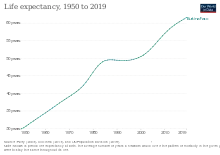
| Period | Life expectancy in Years[9] |
|---|---|
| 1950–1955 | 30.94 |
| 1955–1960 | |
| 1960–1965 | |
| 1965–1970 | |
| 1970–1975 | |
| 1975–1980 | |
| 1980–1985 | |
| 1985–1990 | |
| 1990–1995 | |
| 1995–2000 | |
| 2000–2005 | |
| 2005–2010 | |
| 2010–2015 | |
| 2015–2020 |
Other demographic statistics
Demographic statistics according to the World Population Review in 2022.[10]
- One birth every 40 seconds
- One death every 3 minutes
- One net migrant every 21 minutes
- Net gain of one person every 52 seconds
The following demographic statistics are from the CIA World Factbook, unless otherwise indicated.[11]
Demographic profile
Burkina Faso has a young age structure – the result of declining mortality combined with steady high fertility – and continues to experience rapid population growth, which is putting increasing pressure on the country's limited arable land. More than 65% of the population is under the age of 25, and the population is growing at 3% annually. Mortality rates, especially those of infants and children, have decreased because of improved health care, hygiene, and sanitation, but women continue to have an average of almost 6 children. Even if fertility were substantially reduced, today's large cohort entering their reproductive years would sustain high population growth for the foreseeable future. Only about a third of the population is literate and unemployment is widespread, dampening the economic prospects of Burkina Faso's large working-age population.[11]
Population
- 21,935,389 (2022 est.)
- 21,382,659 (July 2021 est.)
- Note: estimates for this country explicitly take into account the effects of excess mortality due to AIDS; this can result in lower life expectancy, higher infant mortality and death rates, lower population and growth rates, and changes in the distribution of population by age and sex than would otherwise be expected
Religions
Muslim 63.2%, Roman Catholic 24.6%, Protestant 6.9%, traditional/animist 4.2%, none 0.7%, unspecified 0.4% (2017-18 est.)
Age structure

- 0-14 years: 43.58% (male 4,606,350/female 4,473,951)
- 15-24 years: 20.33% (male 2,121,012/female 2,114,213)
- 25-54 years: 29.36% (male 2,850,621/female 3,265,926)
- 55-64 years: 3.57% (male 321,417/female 423,016)
- 65 years and over: 3.16% (male 284,838/female 374,057) (2020 est.)
- 0-14 years: 44.88% (male 4,519,960/female 4,503,937)
- 15-24 years: 20.07% (male 2,024,501/female 2,012,053)
- 25-54 years: 29.42% (male 2,999,941/female 2,915,264)
- 55-64 years: 3.2% (male 284,374/female 359,159)
- 65 years and over: 2.43% (male 181,996/female 306,324) (2017 est.)
Median age
- Total: 17.9 years Country comparison to the world: 216th
- Male: 17.0 years
- Female: 18.7 years (2020 est.)
- Total: 17.3 years
- Male: 17.1 years
- Female: 17.4 years (2017 est.)
Population growth rate
- 2.53% (2022 est.) Country comparison to the world: 20th
- 2.58% (2020 est.) Country comparison to the world: 14th
- 3% (2017 est.)
Birth rate
- 33.57 births/1,000 population (2022 est.) Country comparison to the world: 19
- 34.34 births/1,000 population (2021 est.) Country comparison to the world: 20th
Death rate
- 7.71 deaths/1,000 population (2022 est.) Country comparison to the world: 103rd
- 7.92 deaths/1,000 population (2021 est.) Country comparison to the world: 89th
Net migration rate
- -0.61 migrant(s)/1,000 population (2022 est.) Country comparison to the world: 127th
- -0.62 migrant(s)/1,000 population (2021 est.) Country comparison to the world: 131st
Mother's mean age at first birth
- 19.4 years (2010 est.)
- note: median age at first birth among women 25-29
Total fertility rate
- 4.27 children born/woman (2022 est.) Country comparison to the world: 22nd
- 4.39 children born/woman (2021 est.) Country comparison to the world: 18th
Contraceptive prevalence rate
- 30.1% (2020)
- 32.5% (2018/19)
Urbanization
- urban population: 31.9% of total population (2022)
- rate of urbanization: 4.75% annual rate of change (2020-25 est.)
- Urban population: 30.6% of total population (2020)
- Rate of urbanization: 4.99% annual rate of change (2015-20 est.)
Sex ratio
- At birth: 1.03 male(s)/female
- 0-14 years: 1.03 male(s)/female
- 15-24 years: 1.00 male(s)/female
- 25-54 years: 0.87 male(s)/female
- 55-64 years: 0.76 male(s)/female
- 65 years and over: 0.76 male(s)/female
- Total population: 0.96 male(s)/female (2020 est.)
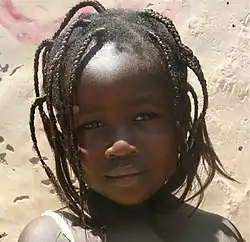
Life expectancy at birth
- total population: 63.44 years
- male: 61.63 years
- female: 65.31 years (2022 est.)
- Total population: 63.06 years
- Male: 61.28 years
- Female: 64.89 years (2021 est.)
HIV/AIDS
Major infectious diseases
- degree of risk: very high (2020)
- food or waterborne diseases: bacterial and protozoal diarrhea, hepatitis A, and typhoid fever
- vectorborne diseases: dengue fever and malaria
- water contact diseases: schistosomiasis
- animal contact diseases: rabies
- respiratory diseases: meningococcal meningitis
note: on 21 March 2022, the US Centers for Disease Control and Prevention (CDC) issued a Travel Alert for polio in Africa; Burkina Faso is currently considered a high risk to travelers for polio; the CDC recommends that before any international travel, anyone unvaccinated, incompletely vaccinated, or with an unknown polio vaccination status should complete the routine polio vaccine series; before travel to any high-risk destination, CDC recommends that adults who previously completed the full, routine polio vaccine series receive a single, lifetime booster dose of polio vaccine
Nationality
- Noun: Burkinabé (singular and plural)
- Adjective: Burkinabé
Ethnic groups

Religions
- Islam 61.5%, Roman Catholic 23.3%, Traditional/Animist 7.8%, Protestant 6.5%, Other/No Answer 0.2%, None 0.7% (2010 est.)
Languages
- French(official), native African languages belonging to Sudanic family spoken by 90% of the population
Literacy
- Definition: age 15 and over can read and write
- Total population: 41.2%
- Male: 50.1%
- Female: 32.7% (2018 est.)
Education expenditure
- 5.4% of GDP (2018)
Slavery
In 2018, an estimated 82,000 people in the country were living under "modern slavery" according to the Global Slavery Index.[13] News reports also indicate that "most child slaves on cocoa farms (Ivory Coast and Ghana) come from Mali and Burkina Faso, two of the poorest nations on Earth. The children, some as young as ten, are sent by their families or trafficked by agents with the promise of money. They are made to work long hours for little or no money."[14]
References
| Wikimedia Commons has media related to Demographics of Burkina Faso. |
- "Population Division of the Department of Economic and Social Affairs of the United Nations Secretariat, World Population Prospects: Data Query". Esa.un.org. Retrieved 2021-01-31.
- "UNSD — Demographic and Social Statistics".
- "Enquête Démographique et de Santé 1993" (PDF). Dhsprogram.com. Retrieved 2017-08-27.
- "Enquête Démographique et de Santé 1998-99" (PDF). Dhsprogram.com. Retrieved 2017-08-27.
- "Enquête Démographique et de Santé 2003" (PDF). Dhsprogram.com. Retrieved 2017-08-27.
- "Enquête Démographique et de Santé 2010" (PDF). Dhsprogram.com. Retrieved 2017-08-27.
- "STATcompiler". www.statcompiler.com. Retrieved 2020-02-17.
- "Nigeria Demographic and Health Survey 2013" (PDF). Dhsprogram.com. Retrieved 2017-08-27.
- "World Population Prospects - Population Division - United Nations". esa.un.org. Retrieved 2021-01-31.
- "Burkina Faso Population 2022", World Population Review
- "The World FactBook - Burkina Faso", The World Factbook, January 31, 2022
 This article incorporates text from this source, which is in the public domain.
This article incorporates text from this source, which is in the public domain. - "Burkina Faso Religions - Demographics".
- "Country Data | Global Slavery Index".
- "The Modern Slavery Bill is a start, but it won't guarantee us sweeter chocolate".
![]() This article incorporates public domain material from the CIA World Factbook website https://www.cia.gov/the-world-factbook/.
This article incorporates public domain material from the CIA World Factbook website https://www.cia.gov/the-world-factbook/.
